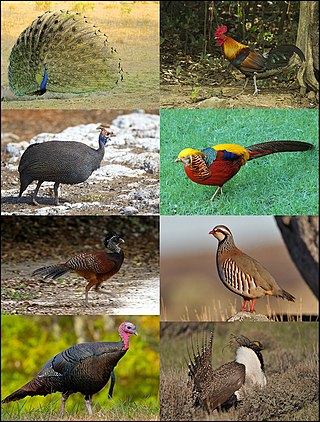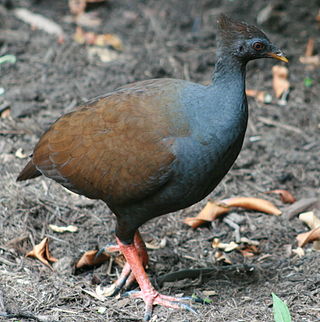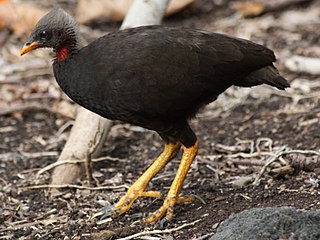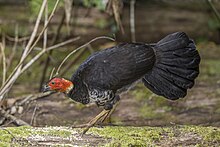
Galliformes is an order of heavy-bodied ground-feeding birds that includes turkeys, chickens, quail, and other landfowl. Gallinaceous birds, as they are called, are important in their ecosystems as seed dispersers and predators, and are often reared by humans for their meat and eggs, or hunted as game birds.

The Australian brushturkey, Australian brush-turkey, or gweela, also frequently called the scrub turkey or bush turkey, is a common, widespread species of mound-building bird from the family Megapodiidae found in eastern Australia from Far North Queensland to Eurobodalla on the South Coast of New South Wales. The Australian brushturkey has also been introduced to Kangaroo Island in South Australia. It is the largest extant representative of the family Megapodiidae, and is one of three species to inhabit Australia.

The Nicobar megapode or Nicobar scrubfowl is a megapode found in some of the Nicobar Islands (India). Like other megapode relatives, it builds a large mound nest with soil and vegetation, with the eggs hatched by the heat produced by decomposition. Newly hatched chicks climb out of the loose soil of the mound and being fully feathered are capable of flight. The Nicobar Islands are on the edge of the distribution of megapodes, well separated from the nearest ranges of other megapode species. Being restricted to small islands and threatened by hunting, the species is vulnerable to extinction. The 2004 tsunami is believed to have wiped out populations on some islands and reduced populations on several others.

The dusky megapode, also known as dusky scrubfowl or common megapode, is a medium-sized, approximately 41 cm long, blackish bird with a short pointed crest, bare red facial skin, dark legs, brown irises, and a dark brown and yellow bill. The male and female are similar. This terrestrial species lives in forests and swamps, including mangroves, of the Maluku and Raja Ampat Islands in Indonesia. Like other megapodes, it lays its eggs in a mound made from earth mixed with leaves, sand, gravel, and sticks, which can be as large as 11 m (36 ft) in diameter and stand nearly 5 m (16 ft) tall.

The red-billed brushturkey also known as red-billed talegalla or Cuvier's brushturkey, is a large, up to 57 cm long, black megapode with bare yellow facial skin, a reddish orange bill, yellow iris, and orange feet. The head is covered with bristle-like black feathers. The sexes are similar.

The orange-footed scrubfowl, also known as orange-footed megapode or just scrubfowl, is a small megapode of the family Megapodiidae native to many islands in the Lesser Sunda Islands as well as southern New Guinea and northern Australia.

The Micronesian megapode or Micronesian scrubfowl is an endangered megapode which inhabits islands of the Western Pacific Ocean.

The Moluccan megapode, also known as Wallace's scrubfowl, Moluccan scrubfowl or painted megapode, is a small, approximately 31 cm long, olive-brown megapode. The genus Eulipoa is monotypic, but the Moluccan megapode is sometimes placed in Megapodius instead. Both sexes are similar with an olive-brown plumage, bluish-grey below, white undertail coverts, brown iris, bare pink facial skin, bluish-yellow bill and dark olive legs. There are light grey stripes on reddish-maroon feathers on its back. The young has brownish plumage, a black bill, legs and hazel iris.

The Sula megapode or Sula scrubfowl is a species of bird in the family Megapodiidae. It is found only in the Banggai and Sula Islands between Sulawesi and the Maluku Islands in Indonesia, where its habitats are subtropical or tropical dry forest, subtropical or tropical moist lowland forest, subtropical or tropical mangrove forest, and subtropical or tropical moist shrubland. It is threatened by habitat destruction.

The Melanesian scrubfowl or Melanesian megapode is a megapode species that is endemic to islands within Melanesia. The Melanesian scrubfowl has a unique strategy of egg incubation in which it relies on environmental heat sources. This bird species is culturally important for Indigenous peoples in Melanesia.

The Vanuatu megapode or Vanuatu scrubfowl is a species of bird in the family Megapodiidae. It was formerly known as the New Hebrides scrubfowl. It is found only in Vanuatu. Its natural habitat is subtropical or tropical moist lowland forest. The species is threatened by habitat loss and egg collecting.

The scrubfowl are the genus Megapodius of the mound-builders, stocky, medium-large chicken-like birds with small heads and large feet in the family Megapodiidae. They are found from south-east Asia to north Australia and islands in the west Pacific.
The Tanimbar megapode or Tanimbar scrubfowl is a small megapode endemic to the Tanimbar Islands of Indonesia. It is sometimes considered to be a subspecies of the orange-footed scrubfowl, Megapodius reinwardt.

Brushturkey, brush-turkey or brush turkey generally refer to birds in three genera in the megapode family, and sometimes to other species such as the Australian bustard:
The Viti Levu scrubfowl, also known as the Fiji scrubfowl or lost megapode, is an extinct megapode that was endemic to Fiji. The epithet amissus, from Latin "lost", refers to its extinction. Subfossil remains were collected from the Udit cave at Wainibuku on the island of Viti Levu in October 1998 by Trevor Worthy, G. Udy and S. Mataraba, and described by Worthy in 2000. The holotype is held by the Museum of New Zealand.
Megavitiornis altirostris is an extinct, flightless, giant stem-galliform bird that was endemic to Fiji, it is the only known species in the genus Megavitiornis. Originally thought to be a megapode, more recent morphological studies indicate a close relationship with Sylviornis of New Caledonia, with both genera belonging to the family Sylviornithidae outside of the Galliformes crown group. It is likely that it became extinct through overhunting shortly after the colonisation of the Fiji Islands by humans.
The consumed scrubfowl is an extinct megapode that was native to Fiji and Tonga in the south-west Pacific Ocean. It was originally described from subfossil remains collected by David Steadman from an archaeological site at Tongoleleka, on the island of Lifuka in the Haʻapai group of the Kingdom of Tonga. The specific epithet and vernacular name refer to its evident use as a food item. Subsequently, remains were also found on Lakeba and Mago in the Lau group of Fiji by Trevor Worthy. It likely became extinct through overhunting following human settlement of the islands some 3,500 years ago but may have persisted until the mid-late 19th century:

Progura is an extinct genus of megapode that was native to Australia. It was described from Plio-Pleistocene deposits at the Darling Downs and Chinchilla in southeastern Queensland by Charles De Vis.

In the biology of birds and mammals, altricial species are those in which the young are underdeveloped at the time of birth, but with the aid of their parents mature after birth. Precocial species are those in which the young are relatively mature and mobile from the moment of birth or hatching. Precocial species are normally nidifugous, meaning that they leave the nest shortly after birth or hatching. These categories form a continuum, without distinct gaps between them.


















